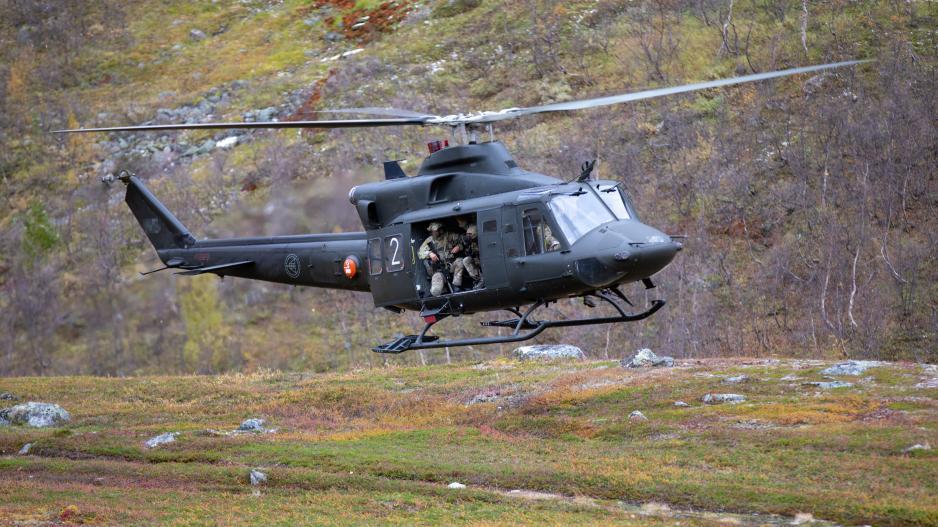Nato’s Military Leader: “We Must Be Prepared for Military Conflicts Arising in the Arctic”
Article by High North News
The headline reads The NATO perspective on the Arctic as Admiral Rob Bauer, chair of the alliance’s military committee, takes the podium at the Arctic Circle Assembly in Iceland.
A threatening Russia, a China with unclear intentions and a stronger interaction between the two – not least in an increasingly navigable Arctic Ocean, is seen through NATO’s north-facing binoculars, outlines Bauer.
“The increasing competition and militarization in the Arctic region, especially by Russia and China, is worrying. The melting ice in the Arctic allows for new sea routes that make sailing easier for larger vessels and shorten the time it takes to navigate,” he says and continues:
“The Arctic is still a Russian military stronghold – home to the Northern Fleet, nuclear submarines, missile facilities, air stations, radar stations, and troop concentrations. Russia’s largest force is based on the Kola Peninsula, which borders Norway and Finland, NATO’s newest member. The presence is constantly expanding with further construction and renovation of military bases. The region also continues to be used as a testing ground for new Russian weapons, including hypersonic missiles and the Poseidon nuclear torpedo drone.”
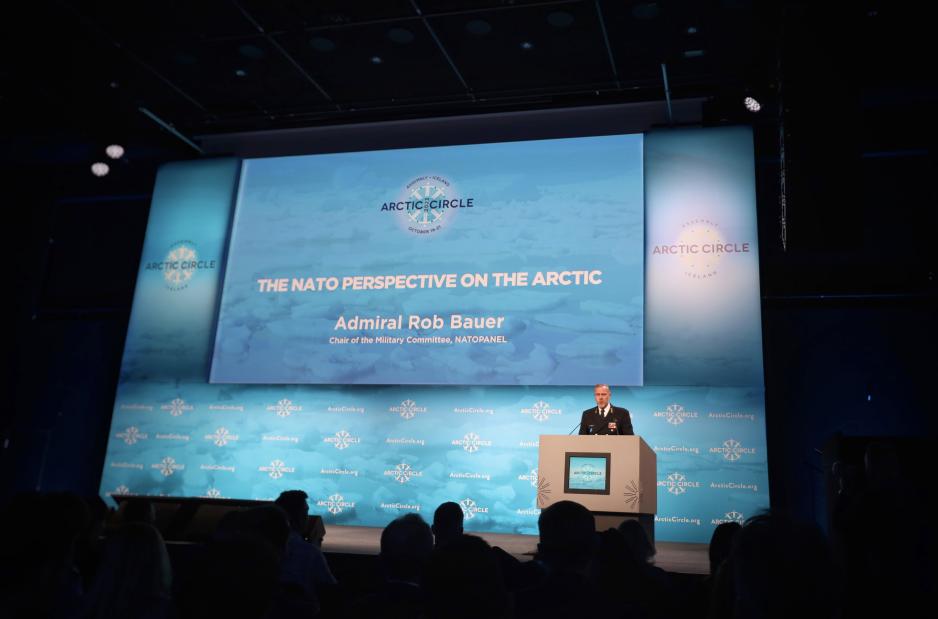
“Russia puts profit over security.”
Admiral Rob Bauer, Chair of the NATO Military Committee
A duo along the Northern Sea Route
As a military advisor to the NATO Secretary General and the North Atlantic Council (NATO’s principal political decision-making body), Admiral Rob Bauer is the alliance’s top military authority.
He is concerned with Russia, “the largest and most direct threat against the alliance’s security,” forming increasingly closer ties with China – and with the activity that follows in the North.
“In March, Russia and China agreed on strengthening their cooperation, particularly within Arctic energy and transport. They seek to establish a joint umbrella organization for traffic along the Northern Sea Route (NSR). So far, this has led to a wave of Russian shipments of crude oil to Chinese ports along this route.”
Bauer highlights that Russia has sent an oil tanker without ice protection through the Arctic to China for the first time.
“Experts consider this to be reckless behaviour. Russia has denounced long-term practice with ice protection and puts profit over security,” emphasizes the admiral of the Dutch Navy.
He also points to the fact that a Chinese container ship has sailed along the NSR from China to St. Petersburg and back.
“This is the first step in establishing a regular, albeit small-scale, container line service along Russia’s Northern Sea Route.”
“China’s intentions in the region remain opaque.”
Admiral Rob Bauer, Chair of the NATO Military Committee
Worried
“We cannot be naive and expect the Northern Sea Route to only be used by commercial vessels,” notes Admiral Bauer.
He refers to the letter of intent that the FSB and the Chinese Coast Guard signed this spring on maritime security cooperation – which opens up for collaboration between the countries’ coast guards in Arctic waters (Norwegian only).
“Over the last decade, China has invested over USD 19 billion in Arctic energy and mineral projects, primarily in Russia. China is also the largest investor in the Siberia 2 gas pipeline – a project with an estimated cost of USD 55 billion.
“In June, when the Russian MFA Sergey Lavrov referred to China as Russia’s most important partner in the Arctic, he was right. This worries us. Because while Russia’s intentions in the Arctic has become clearer in later years, China’s intentions in the region remains opaque,” states Bauer.
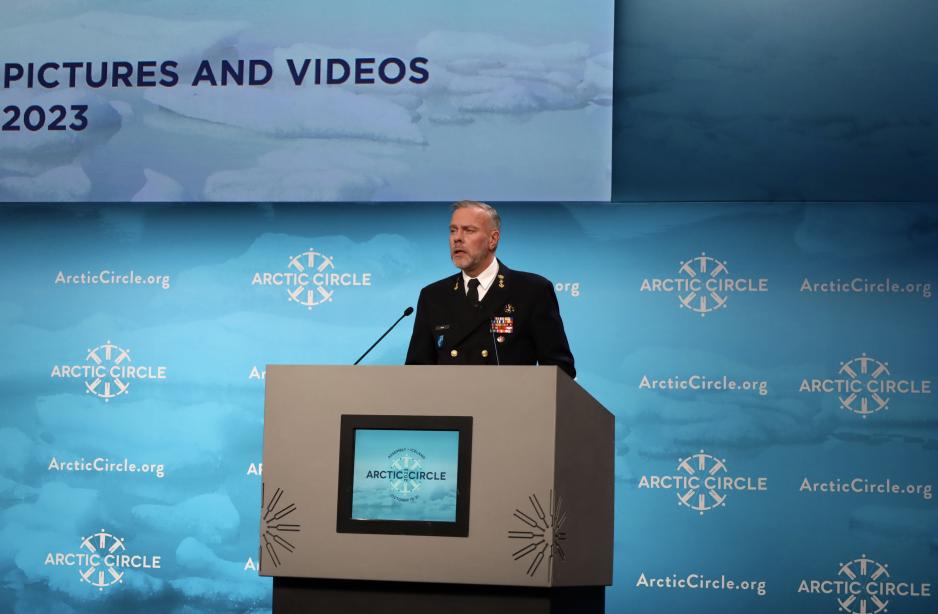
“Dialogue fell through”
The Chair of NATO’s Military Committee also focuses on the extensive cooperation between the East and West in the Arctic which has largely unraveled after Russia’s war against Ukraine.
“For many years, the Arctic has benefited from border-crossing cooperation and dialogue, like within the Arctic Council and the Barents Euro-Arctic cooperation. These formats provided the space for constructive contact with Russia with emphasis on building trust, reducing tension, and managing joint issues. In sum, these structures preceded an era that has rightly been described with the term ‘High North, low tension,’ says Bauer and continues:
“But dialogue and cooperation with Russia have fallen through. First in the Arctic Council, where dialogue and activities were put on hold just after the invasion of Ukraine – and just recently resumed thanks to guidelines agreed upon by all members. Then with Russia’s recent announcement that it is withdrawing from the Barents Euro-Arctic Council, in which it blames western members for effectively having paralyzed the council’s work since March 2022.”
“When dialogue fails, when one is facing an unpredictable regional actor and sees increasingly unfavorable activity in the region from another actor with unclear intentions, NATO has no other choice than to prepare for the unexpected.”
But it can be added that through dialogue, diplomats have succeeded in creating a light in the tunnel for the Arctic Council.
“The Russian threat may also come from the High North.”
Admiral Rob Bauer, Chair of the NATO Military Committee
NATO’s measures
“While NATO remains an defensive alliance with ambitions to prevent conflict and ensure that tensions stays low in the High North, the present security situation has necessitated a more firm response from the alliance,” states Bauer.
“We must prepare for the fact that conflict can present itself at any moment and in any domain, including the Arctic. The Russian threat can also come from the High North.”
Furthermore, the admiral elaborates on how NATO has strengthened deterrence, defense, and vigilance in the Arctic.
A first example is the alliance’s new regional defense plans:
“The regional plan for the northwest specifically deals with the Atlantic and the European Arctic. The region falls under our newest allied joint force command in Norfolk, US. JFC Norfolk ensures that NATO’s force posture supports Arctic operations and makes the Arctic defense more cohesive. This ensures that forces and equipment can flow between the continents in both conflict and peace and protects freedom of navigation.”
In September, Bauer led a conference within NATO’s Military Committee in Oslo focusing on how the regional plans should be implemented (Norwegian only).
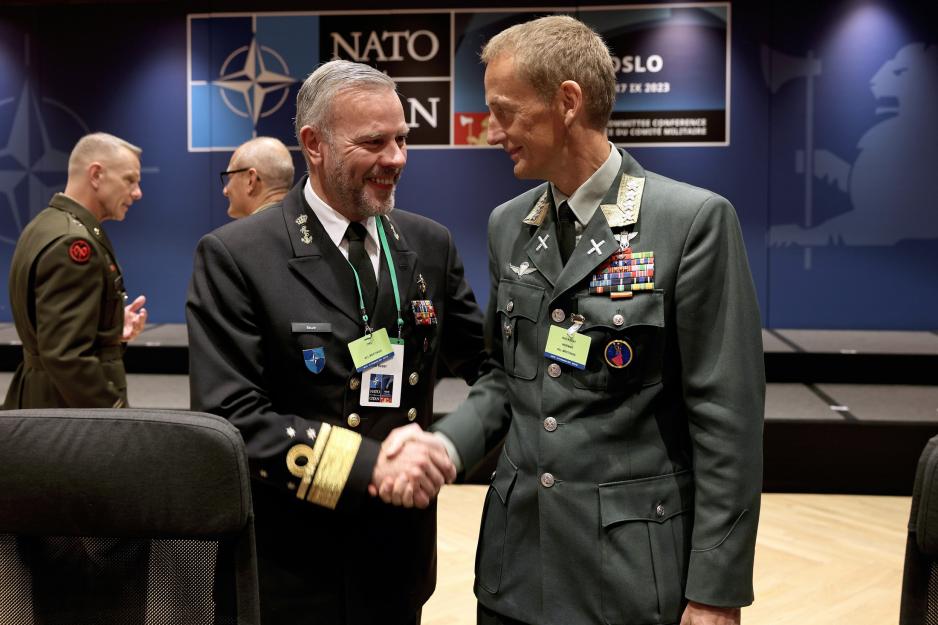
Subsea infrastructure
The alliance is also focused on the protection of cables and pipelines in Northern waters.
“As the gateway to the Arctic, the North Atlantic is also an arena for vital trade and communications links between North America and Europe. 1,3 million kilometers of subsea cables allows for daily financial transactions of about USD 10 trillion,” notes Bauer and continues:
“After the sabotage against the Nord Stream pipelines and the recent damage to the Finnish-Estonian pipeline, we have further increased our vigilance. NATO has doubled the number of ships that patrol the North Sea and the Baltic Sea and stepped up the sharing of intelligence.”
“The NATO countries have also agreed on establishing an undersea infrastructure coordination cell to map vulnerabilities, and coordinate efforts between allies, partners, and private sector – as well as a specialized center for securing critical subsea infrastructure under NATO’s maritime command.”
The Nordic region in NATO
Furthermore, Bauer highlights Norway, Finland, and Denmark’s increase in defense budgets – and investments in new capabilities such as fighter jets and ships for strengthened patrolling of air and sea space also in the Arctic, particularly on the lookout for non-allied submarines.”
The admiral also emphasizes stronger Nordic defense cooperation.
“Our Nordic allies are also working on closer coordination of their defenses. Norway, Sweden, Finland, and Denmark have agreed on operating their about 250 fighter jets as a joint operative air fleet, as well as contributing to Iceland Air Policing. Deepened collaboration between the Nordic nations will strengthen the focus on shared objectives and maximize the potential which lies in joint defense planning for the region.”
More exercises
“In addition, NATO and the allies have increased their exercise activity in the Arctic. We regularly conduct various exercises, such as within anti-submarine warfare, to ensure that our forces are ready to operate in all conditions. We are testing rapid movement of troops, their deployability, and interoperability,” says Bauer.
The Chair of NATO’s Military Committee highlights three central exercises that have been held in the region this year:
- The marine exercise in the major Canadian-led Operation Nanook in Northern Canada with participation from the US, France, and Denmark in August-September.
- The special force exercise Adamant Serpent, led by the US Special Operations Command Europe with participants from Canada, Finland, Norway, Sweden, and the UK in September. As part of the training, Norwegian and American special forces trained together in inland areas of Troms, Northern Norway. Other areas of exercise have not been specified.
- The Norwegian-led exercise Joint Viking, with its main focus on the land domain and its maritime addition, the British-led exercise Joint Warrior, in Northern Norway in March. A total of 11 other allied countries participated.
“Next year, the Nordic countries will host Nordic Response, formerly known as Cold Response, as part of the major NATO exercise Steadfast Defender. This will be an important milestone within further Nordic integration and for our new regional plan for the northwest.”
“NATO is now more prepared, secure, and united than ever,” the admiral states.
Overall, the chair of NATO’s Military Committee describes increased militarization of the Arctic both from the Russian and the Western side.
At the same time, the hotline between top military leaders in NATO and Russia for rapid de-escalation is still fallow, says Bauer. He first announced this last fall at the Halifax International Security Forum in Canada (Norwegian only).
“I have now tried to get in touch with the head of Russia’s general staff and deputy MoD, General Valery Gerasimov, four times. However, he does not want to have a dialogue with me. At first the response was that he was busy with the ‘special operation’ and would get back to me. Then he replied that ‘NATO is part of the problem, and I will only talk to you if NATO withdraws its support from Ukraine'”, says the admiral and continues:
“My last inquiry to Gerasimov was about the Russian drone parts that landed in NATO territory in Romania after an attack near the Ukrainian-Romanian border, and we wanted to find out whether this was intentional or not. Military-to-military contact is very important to clarify whether things are done on purpose or not. If it is found that something was an accident, a completely different discussion follows than if something was intentional. That is why we should absolutely have such a dialogue – it can be extremely important.”
NATO is on the other hand in military dialogue with China. Bauer annually meets a Chinese delegation in Singapore to exchange views on current issues between the parties.
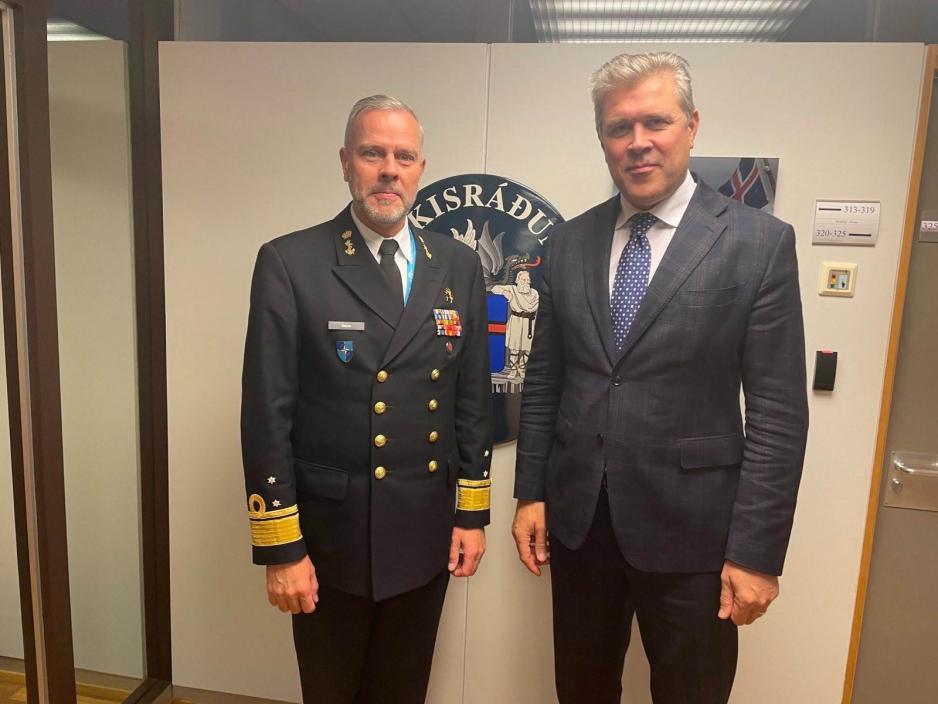
Praise for Iceland
During his stay in Iceland, Bauer also met with the country’s Chief of Defense, Jónas Allansson, and the new MFA, Bjarni Benediktsson.
“Iceland is a smaller nation with a small population, but you still contribute meaningfully to our Alliance. Among other things, you are the host strategic NATO and Allied assets, have personnel deployed on our eastern flank, and you increase our situational awareness in the North Atlantic. In addition, you show true leadership on the Women, Peace and Security agenda. And you support key partners, including Ukraine,” Bauer maintained.
“When Sweden joins, following in the footsteps of Finland, seven of the eight members of the Arctic Council will be NATO allies. We are grateful to our Nordic allies for their their enhanced cooperation, investment and vigilance in the region. The Arctic has always had strategic importance for NATO, and we must ensure it remains free and navigable.”
